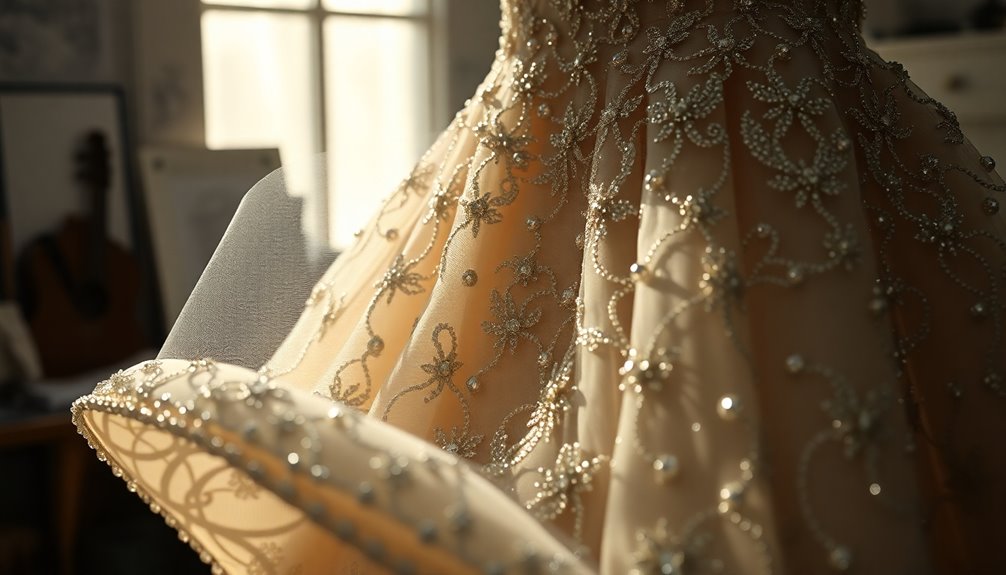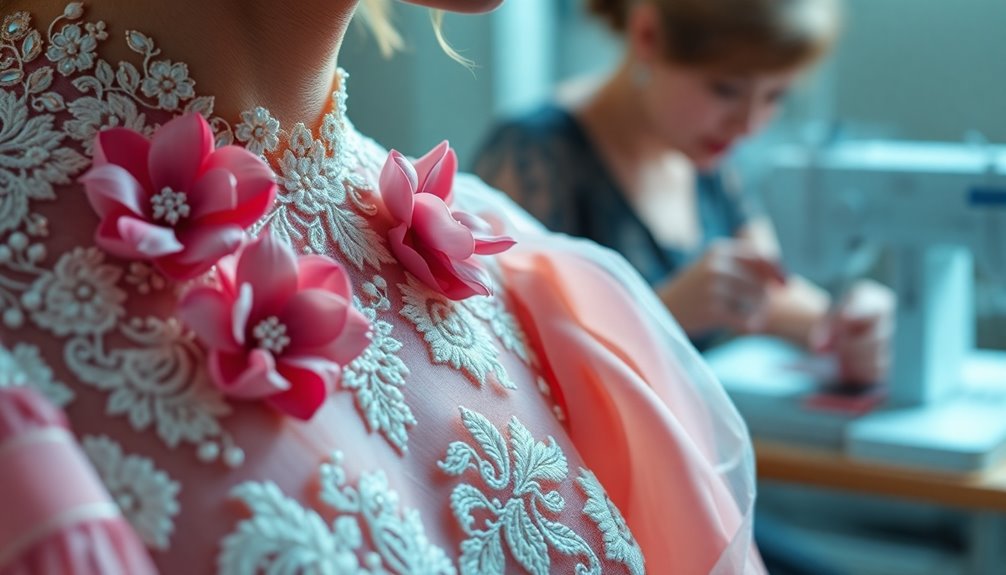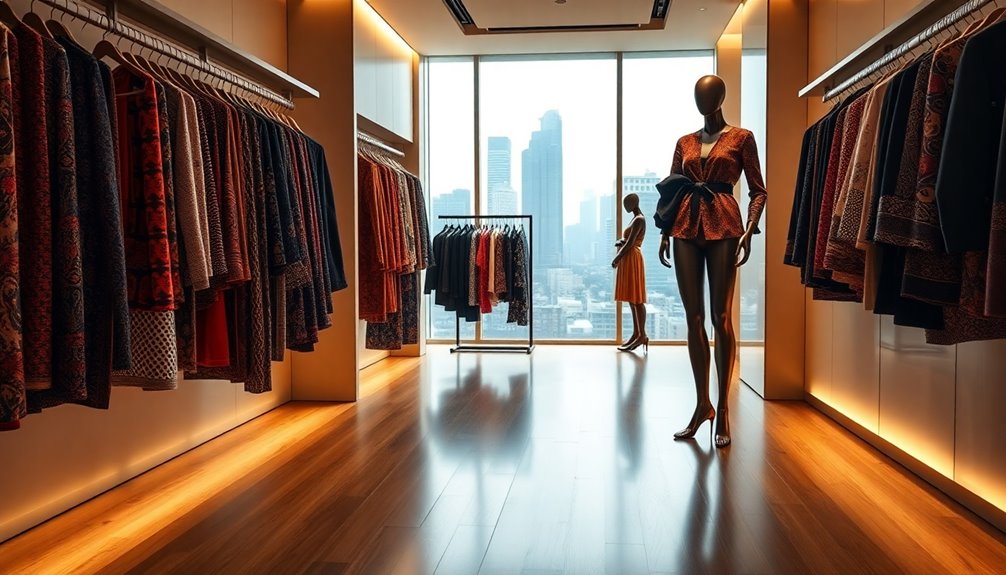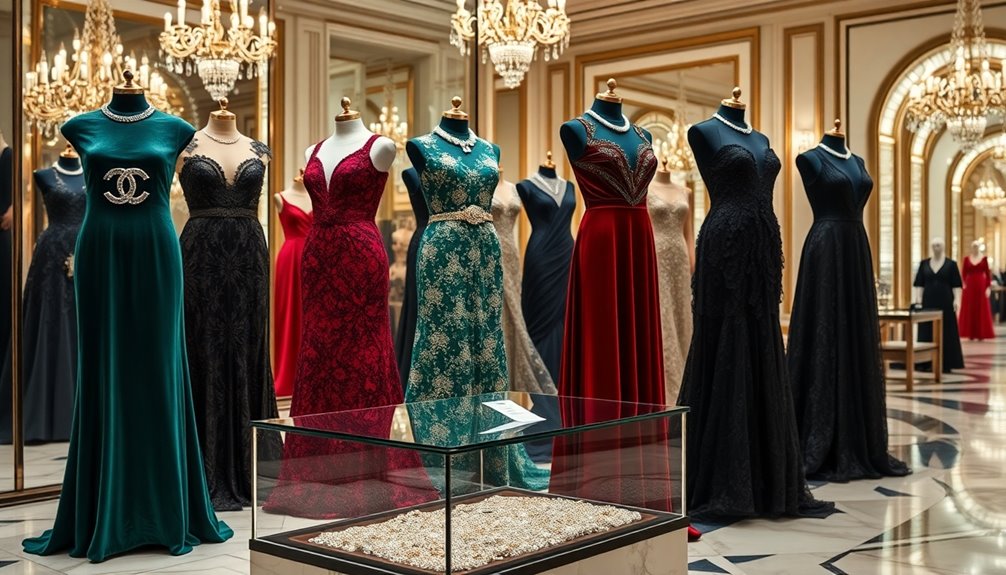Haute couture isn't just about luxury; it's where art meets meticulous craftsmanship. You're stepping into a territory where each piece takes hundreds of hours to create, often requiring dozens of skilled artisans. It's an exclusive domain, with only about 2,000 women globally wearing these one-of-a-kind garments. The legacy began with Charles Frederick Worth and evolved through societal changes, influencing modern trends. Legal restrictions guarantee authenticity, making haute couture a status symbol. This world reveals hidden narratives of artistry and exclusivity that most miss. And there's so much more to explore about its vibrant culture and economic impact.
Key Takeaways
- Haute couture represents exclusive, custom-fitted fashion, requiring legal approval and adherence to strict industry standards established in 1945.
- Each haute couture piece can take 150 to over 1,000 hours to create, showcasing meticulous craftsmanship by skilled artisans.
- The price of haute couture garments ranges from $9,000 to over $1,000,000, making them a significant investment in luxury and artistry.
- Only around 2,000 women globally engage with haute couture, emphasizing its exclusivity and status as a symbol of wealth and individuality.
- The evolution of haute couture reflects changing societal values, blending traditional craftsmanship with contemporary trends to appeal to diverse clientele.
Understanding Haute Couture

Understanding haute couture means delving into a world of exclusive fashion that's custom-fitted for a select clientele. The term translates to "high sewing" in French and signifies a commitment to unique designs crafted for the affluent.
Since 1945, legal protections guarantee that only approved brands can label their creations as haute couture, overseen by the Chambre Syndicale de la Haute Couture. To qualify, ateliers must employ a minimum of 15 full-time staff and showcase at least 50 original designs each season.
This rigorous standard preserves the artistry and craftsmanship that define haute couture, making each piece a representation of luxury and individuality. It's not just fashion; it's a declaration of status and personal expression.
The Evolution of Couture

Haute couture has undergone significant changes since its inception, reflecting shifts in society, culture, and fashion. You can trace this evolution through key milestones:
- Founding Era: Charles Frederick Worth established the first haute couture house in 1858, setting the stage for exclusive fashion.
- Legal Protections: In 1945, regulations emerged to protect the term "haute couture," ensuring only select brands could claim it.
- Post-War Revival: The post-WWII era saw a resurgence in couture, influenced by societal changes and the rise of iconic designers.
- Modern Adaptations: Today, haute couture embraces innovation, balancing traditional craftsmanship with contemporary trends, appealing to a diverse clientele.
This evolution underscores haute couture's adaptability and its reflection of changing cultural narratives.
Craftsmanship Behind the Garments

In the world of haute couture, the craftsmanship behind each garment is nothing short of extraordinary.
You'll find that creating a single piece can take anywhere from 150 to over 1,000 hours, with every stitch crafted entirely by hand. During multiple fittings, skilled artisans guarantee perfect customization, incorporating intricate hand-sewn details and embellishments that elevate the piece into wearable art.
Each garment typically requires a minimum of 20 talented artisans, all dedicated to executing techniques that highlight the premium quality of fabrics used.
This meticulous attention to detail not only reflects the designer's vision but also celebrates the artistry involved in haute couture, transforming each creation into a unique masterpiece that resonates with luxury and exclusivity.
Economic Aspects of Haute Couture

How does the economic landscape shape the allure of haute couture? The exclusive nature of haute couture drives its high prices, making it a symbol of luxury and status. You're not just buying a garment; you're investing in art and craftsmanship.
Here are some key economic aspects to evaluate:
- Price Range: Haute couture pieces range from $9,000 to over $1,000,000.
- Market Impact: The industry contributes around $1 billion annually to the luxury fashion market.
- Artisan Support: It supports local artisans and suppliers, creating jobs and preserving craftsmanship.
- Client Exclusivity: Only about 2,000 women globally wear haute couture, heightening its desirability.
These factors intertwine to create a vibrant yet challenging economic ecosystem that defines haute couture.
The Exclusive Clientele

The allure of haute couture is magnified by its exclusive clientele, which includes only about 2,000 women worldwide. These discerning individuals seek more than just clothing; they desire unique pieces that reflect their status and personal style.
With approximately 200 of the 4,000 official clients returning regularly, the relationships between clients and couture houses deepen, fostering a sense of intimacy and trust. Significantly, around 60% of these clients hail from America, emphasizing the global reach of haute couture.
Each piece is either one-of-a-kind or produced in very limited quantities, enhancing desirability. This exclusivity not only solidifies the prestige of haute couture but also creates a community of influential women who shape trends and redefine luxury in fashion.
Artistic Expression and Culture

Artistic expression in haute couture transcends mere clothing; it's a vibrant dialogue between designers and culture. Each piece not only showcases exquisite craftsmanship but also embodies cultural narratives and societal values.
When you explore haute couture, you'll discover:
- Cultural Reflection: Designs often mirror historical events and social movements.
- Artistic Innovation: Each collection pushes the boundaries of creativity, blending art and fashion.
- Individuality: Tailored garments allow for personal expression, celebrating diverse identities.
- Global Influence: Haute couture inspires trends worldwide, impacting local fashion scenes.
Through these elements, haute couture becomes more than fashion; it's a living art form that captivates and engages, allowing you to appreciate the deeper connections between style and culture.
The Role of Fashion Shows

Fashion shows play a crucial role in the world of haute couture, serving as vibrant platforms where artistry and innovation collide. They showcase the latest collections, allowing designers to present their visions to an audience enthusiastic for inspiration.
Each runway transforms into a theatrical experience, highlighting not just garments but the craftsmanship behind them. High-profile clients and celebrities often grace the front rows, amplifying the desirability of the pieces.
Challenges Facing Haute Couture

While haute couture embodies luxury and exclusivity, it faces significant challenges that threaten its very essence. You might notice that economic shifts and a growing trend toward fast fashion dilute the allure of bespoke garments.
Here are some key challenges:
- Economic Factors: Fluctuating economies impact clients' spending habits, jeopardizing sales.
- Sustainability Concerns: Increasing scrutiny over environmental practices pushes houses to adapt, which can conflict with traditional methods.
- Limited Clientele: With only around 2,000 women globally wearing haute couture, attracting new customers is tough.
- Cultural Relevance: As societal values change, haute couture must evolve to maintain its artistic significance and connection to contemporary culture.
Navigating these challenges is essential for haute couture to preserve its legacy and relevance in today's fashion landscape.
Frequently Asked Questions
How Can I Become a Haute Couture Client?
To become a haute couture client, you'll need to connect with a reputable couture house.
Start by researching brands that resonate with your style and values. Attend fashion events, build relationships with designers, and express interest in custom pieces.
Be prepared for a significant financial commitment, as haute couture garments can be quite expensive.
Finally, embrace the exclusivity—each piece is tailored just for you, making it a unique work of art.
What Materials Are Commonly Used in Haute Couture Garments?
Imagine slipping into a garment that feels like a second skin.
In haute couture, the materials used are nothing short of extraordinary. You'll find luxurious silks, delicate lace, and sumptuous velvets, each chosen for its unique texture and drape.
Hand-embroidered details often feature shimmering beads or intricate appliqués, elevating the piece to wearable art.
Every fabric tells a story, and you'll feel the craftsmanship woven into every seam when you wear it.
Are Haute Couture Garments Tailored for Specific Body Types?
Yes, haute couture garments are tailored for specific body types.
Designers take your unique measurements and preferences into account during the creation process, ensuring a perfect fit.
You'll experience multiple fittings, allowing artisans to adjust the garment to flatter your silhouette.
This meticulous attention to detail highlights the artistry of haute couture, making each piece not just a garment, but a personalized work of art that celebrates your individuality.
How Do Designers Select Inspiration for Their Haute Couture Collections?
Imagine a designer surrounded by vibrant fabrics, sketches scattered like fallen leaves.
When you create haute couture, inspiration flows from everywhere—art, nature, history, and even personal experiences. You might find a color palette in a sunset or a silhouette in a vintage painting.
Each collection reflects a story, a mood, or a cultural moment. By weaving these influences together, you craft not just garments, but wearable art that resonates with emotion and individuality.
What Is the Significance of Couture Fashion in Contemporary Culture?
Couture fashion holds immense significance in contemporary culture, showcasing artistry and creativity. When you explore these intricate designs, you notice how they reflect societal values and individual expression.
Couture often influences mainstream fashion trends, pushing boundaries and inspiring designers. It serves as a status symbol, emphasizing exclusivity and luxury.
Conclusion
As you journey through the enchanting world of haute couture, you've glimpsed the artistry reminiscent of a masterful painting, each garment a stroke on the canvas of fashion. The allure of exclusivity and craftsmanship captivates, much like the fleeting beauty of a rare flower. While challenges loom like shadows in the background, the spirit of haute couture endures, inviting you to celebrate its legacy and innovation. Embrace the magic that lies within this exquisite domain, where dreams are stitched into reality.










